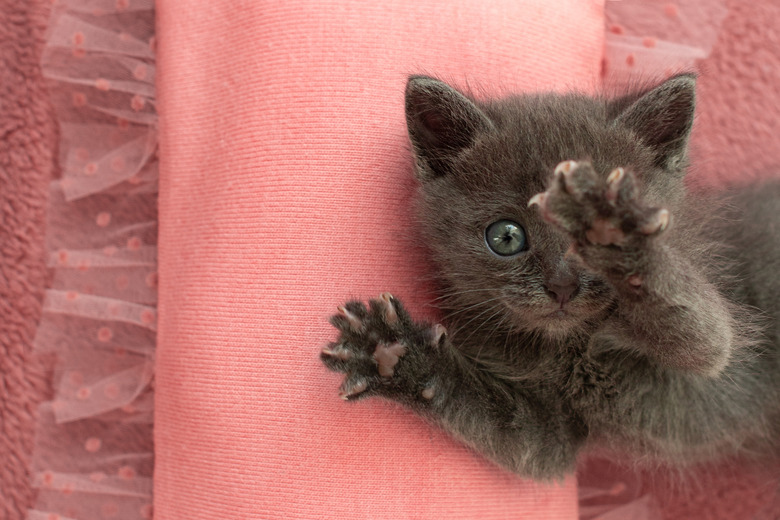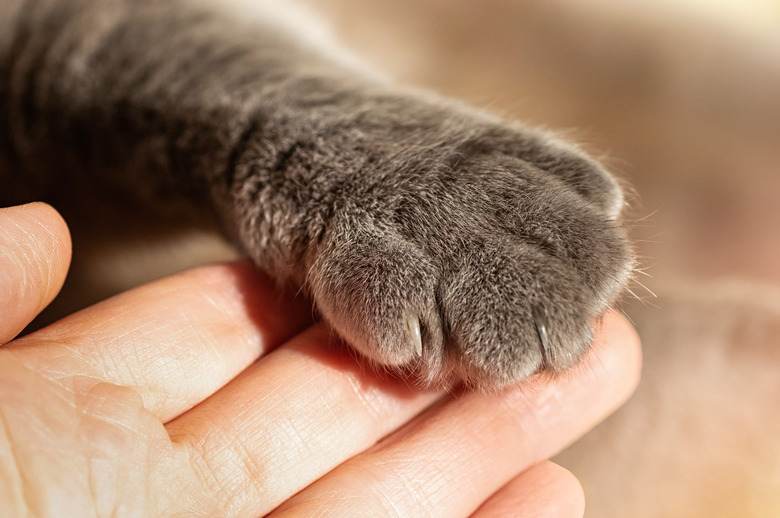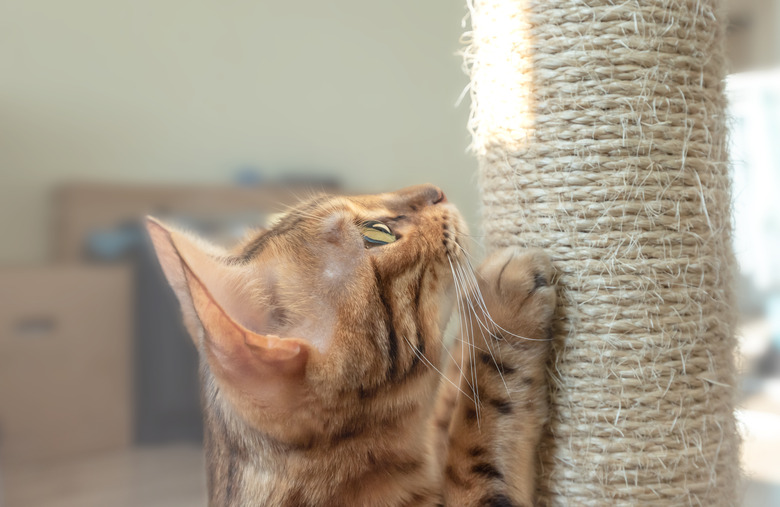Why Does My Cat Claw Me When I Pet Her?
We may receive a commission on purchases made from links.
Cuteness may earn compensation through affiliate links in this article.
Baking pies, kneading bread, giving little massages... whatever phrase you use to describe what happens when your cat presses her paws into a surface is usually used to describe a contented feline. Sometimes, when petting sessions are extra enjoyable, the claws may come out, but why? Usually, extended claws are no cause for concern, but can be a sign of distress depending on your cat's mood. Learning to read your cat's body language can help you decipher between a cat who wants affection and one who needs space.
Clawing and stress release
Clawing and stress release
A cat's claws are often compared to our fingernails, but feline claws are more similar to the first two knuckles on our fingers, anatomically. When a cat extends her claws, especially when she's in a relaxed state, like curled up on the couch and being petted by her favorite person, it can feel like a soothing stretch of muscles, according to The Humane Society. If your cat's claws simply extend when she presses her paws into you or a soft blanket while being petted, there isn't much reason to be concerned. Claw extension and scratching, however, are somewhat different behaviors.
Cat body language and warning signs
Cat body language and warning signs
The best way to tell if your cat's clawing behavior is a response to enjoyment or a signal to back off is to read their body language. Most commonly, body movements like laid back ears, tail lashing, and raised fur or hackles are signs that a cat is seeking space and safety, The Humane Society adds. Signs of contented behavior often include purring, forward-turned ears, and kneading. Extended claws during kneading is normal and rarely cause for concern, and is usually a tell-tale sign of a happy cat.
Cats can also engage in what's known as destructive scratching, which rarely occurs to intentionally destroy, but can result in damaged furniture, clothing, and even walls and carpeting. According to the ASPCA, destructive scratching can happen when a cat plays, sharpens his nails, stretches or marks his territory, but rather than relaxed claw extension, involves overtly scratching a surface.
Additionally, you may notice biting at some point during a petting session, which can be a sign of petting induced aggression. According to VCA Hospitals, this is known as a "go away" bite, and can occur at any time — you've probably noticed your cat do this seemingly out of nowhere, even after enjoying a good snuggle. These bites occur when your cat has simply had enough affection, and bites often occur after very subtle warning signs are offered, like tensing up or dilated pupils.
Keeping your cat happy
Keeping your cat happy
Cats love to scratch, and in many ways, doing so does wonders for their physical and mental wellbeing. To reduce destructive scratching around the home, cover surfaces that you don't want scratched, and be sure to provide plenty of appropriate places for your cat to scratch instead, like a scratching post.
Scratching stations can be cute, decorative, or whimsical besides being functional: Frisco Cactus Cat Scratching Post can add fun to southwest decor or a child's room. PetFusion 3-Sided Vertical Cat Scratching Post has multiple angles for cats that love scratching the corners of furniture, as well as opportunities for perching and hiding.
Additionally, keep plenty of toys around for her to play with, which can prevent destruction as an answer to boredom, and allow her to engage in play and exercise on a daily basis. SnugglyCat Ripple Rug Cat Activity Play Mat has waves and holes for your kitty to claw her way through, and velcro makes it easy to reconfigure the mat for an entirely different experience.
Keeping your cat's nails trimmed may also reduce unwanted scratching around the house. A Top Performance Cat Grooming Bag can help your cat feel cozy and keep him from climbing you like a tree while you snip and file. The bag holds your feline securely while you unzip one paw at a time.
In conclusion
In conclusion
When your cat extends her claws while you are petting her, is it most likely a sign of happiness and relaxation. This is especially true when it's paired with positive body language signs, like purring. If your cat is doing more than just extending her claws and begins scratching you or a nearby surface, like blankets or furniture, perhaps paired with a warning bite, it could be a show to petting induced aggression, or simply, destructive scratching, either of which should not be encouraged.
Rather than scold your cat for scratching, stop petting when the claws come out and give your cat the space she is asking for. To reduce destructive scratching in the home, make sure to keep plenty of appropriate scratching surfaces available, like scratching posts, so your cat may indulge in this natural and healthy cat behavior.


